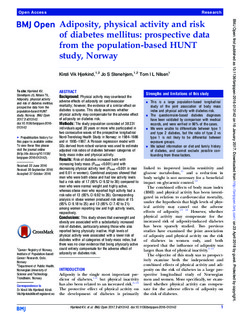| dc.contributor.author | Vik, Kirsti Lund | |
| dc.contributor.author | Stenehjem, Jo Steinson | |
| dc.contributor.author | Nilsen, Tom Ivar Lund | |
| dc.date.accessioned | 2018-04-23T14:14:37Z | |
| dc.date.available | 2018-04-23T14:14:37Z | |
| dc.date.created | 2017-08-01T13:19:18Z | |
| dc.date.issued | 2017 | |
| dc.identifier.issn | 2044-6055 | |
| dc.identifier.uri | http://hdl.handle.net/11250/2495522 | |
| dc.description.abstract | Background Physical activity may counteract the adverse effects of adiposity on cardiovascular mortality; however, the evidence of a similar effect on diabetes is sparse. This study examines whether physical activity may compensate for the adverse effect of adiposity on diabetes risk.
Methods The study population consisted of 38 231 individuals aged 20 years or more who participated in two consecutive waves of the prospective longitudinal Nord-Trøndelag Health Study in Norway: in 1984–1986 and in 1995–1997. A Poisson regression model with SEs derived from robust variance was used to estimate adjusted risk ratios of diabetes between categories of body mass index and physical activity.
Results Risk of diabetes increased both with increasing body mass (Ptrend <0.001) and with decreasing physical activity level (Ptrend <0.001 in men and 0.01 in women). Combined analyses showed that men who were both obese and had low activity levels had a risk ratio of 17 (95% CI 9.52 to 30) compared to men who were normal weight and highly active, whereas obese men who reported high activity had a risk ratio of 13 (95% CI 6.92 to 26). Corresponding analysis in obese women produced risk ratios of 15 (95% CI 9.18 to 25) and 13 (95% CI 7.42 to 21) among women reporting low and high activity levels, respectively.
Conclusions This study shows that overweight and obesity are associated with a substantially increased risk of diabetes, particularly among those who also reported being physically inactive. High levels of physical activity were associated with a lower risk of diabetes within all categories of body mass index, but there was no clear evidence that being physically active could entirely compensate for the adverse effect of adiposity on diabetes risk. | nb_NO |
| dc.language.iso | eng | nb_NO |
| dc.publisher | BMJ Publishing Group | nb_NO |
| dc.rights | Navngivelse-Ikkekommersiell 4.0 Internasjonal | * |
| dc.rights.uri | http://creativecommons.org/licenses/by-nc/4.0/deed.no | * |
| dc.title | Adiposity, physical activity and risk of diabetes mellitus: Prospective data from the population-based HUNT study, Norway | nb_NO |
| dc.type | Journal article | nb_NO |
| dc.type | Peer reviewed | nb_NO |
| dc.description.version | publishedVersion | nb_NO |
| dc.source.volume | 7 | nb_NO |
| dc.source.journal | BMJ Open | nb_NO |
| dc.source.issue | 1 | nb_NO |
| dc.identifier.doi | 10.1136/bmjopen-2016-013142 | |
| dc.identifier.cristin | 1483641 | |
| dc.description.localcode | Published by the BMJ Publishing Group Limited. This is an Open Access article distributed in accordance with the Creative Commons Attribution Non Commercial (CC BY-NC 4.0) license. | nb_NO |
| cristin.unitcode | 194,65,20,0 | |
| cristin.unitname | Institutt for samfunnsmedisin og sykepleie | |
| cristin.ispublished | true | |
| cristin.fulltext | original | |
| cristin.qualitycode | 1 | |

